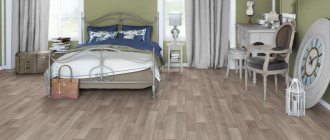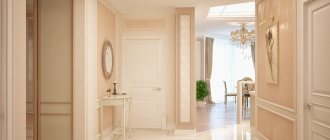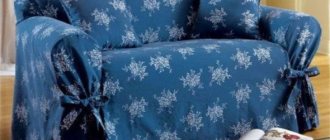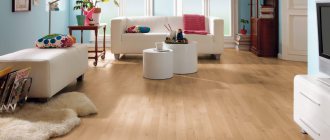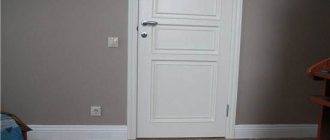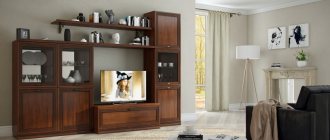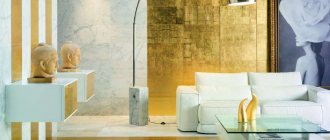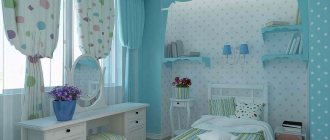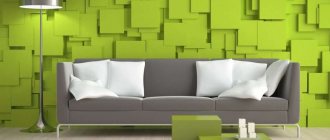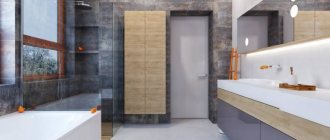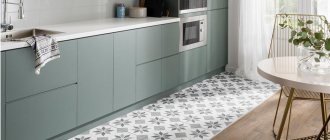The surface of the floor is designed to create a winning background for the furniture in the room. A modern, promising material - laminate - is currently recognized as a worthy option for decorating a living room. Laying laminate flooring in the living room is an excellent solution for creating any interior.
The living room occupies a special place in the house. Its finishing is usually thought out especially carefully. All interior elements should be in harmonious unity. And, accordingly, a special role is assigned to the floor covering.
Characteristics of flooring for the living room
When choosing a type of laminate, you should take into account the specifics of the living room space. We must remember that the living room is one of the most visited rooms in the house. Therefore, one of the important requirements for flooring is increased strength of the material and abrasion resistance of the surface layer.
Laminate flooring for any room is primarily selected according to load class. At the very beginning, when the production of laminated flooring material was just starting, class 23 was considered suitable for the living room.
However, in our time, no one is satisfied with its consumer properties, and it has been discontinued.
To finish the floor in the living room, laminate flooring is selected, starting with class 31 abrasion resistance.
The indicators that determine a suitable laminate for a living room are the thickness of the surface layer and the total thickness of the board. Class 32 is considered optimal for the living room: the thickness of the film that creates a durable surface reaches 0.2 - 0.4 millimeters. It will last up to 11 years.
If you do not plan to cover the living room floor with carpet, and extremely active children and large dogs will move around it intensively, you should opt for class 33. Here, the thickness of the top layer reaches 0.4 - 0.9 millimeters, which prolongs its operation up to 14 years.
As the class level increases, the thickness of the laminate board increases. The floor in the living room should be thick enough - this provides the coating with strength and the necessary level of thermal insulation.
To soften the specific sound that accompanies steps on the laminated flooring, a thick elastic backing is certainly laid under it.
Laminate on the ceiling
The advantages of ceilings designed using laminated elements are similar to the option of using it on vertical surfaces. In addition, it can be noted that such finishing, thanks to reflected light, helps to significantly improve the illumination of the premises.
The installation method leaves the owners a choice - to make a sheathing or a full-fledged frame for fixing individual lamellas to it. In the second case, it is easy to place the necessary communications under the finishing. Laminate can be glued to a perfectly flat ceiling.
What to consider when choosing laminate flooring for your living room
We have identified several factors that you should immediately pay attention to.
The choice of color, texture, and pattern of the laminate depends on the overall design of the living room.
The choice is also influenced by the lighting in the living room and its area.
Good wear resistance is important. For example, if you have a habit of walking around the room in shoes or have animals, then you need to select a coating with sufficient performance capabilities. Laminate flooring marked class 33, no lower, has these characteristics.
To make repairs well and for a long time, you can pay attention to vinyl laminate. This coating is guaranteed to last for more than 30 years.
Gray laminate floor
The main advantage of a gray floor is its ability to fit harmoniously into interiors of various styles and look noble in them without attracting attention. This color can be considered the most diverse. Its shades range from an ash-pearl palette to dark charcoal options. And if a dark floor can act as an accent or background, then light gray gives a feeling of cool freshness and constant movement of air flow.
Carefully! Carefully select the color of the walls in rooms with gray laminate flooring. It is quite capricious in a duet with cold colors.
Emotionally, monochrome gray shades give a feeling of confident balance, relieving accumulated tension. Therefore, such a floor is in demand in the bedroom area and in the living room. On the practical side, gray coating is suitable for corridors and hallways.
What determines the thickness of the laminate and how it affects its service life
The first step in choosing laminate flooring for the living room is to clearly determine the time during which it should remain in perfect condition. You can understand what role the thickness of the laminate plays in this by understanding the structure of the coating:
- The first layer is stabilizing. It consists of corrugated paper and protects the next word from moisture and is a kind of seal.
- The base layer, consisting of durable chipboard, is the thickest and stiffest of all and directly affects the overall thickness of the panel.
- A decorative layer that is visible to the naked eye. It is based on special paper or furniture foil with a printed pattern that imitates a certain structure.
- The last layer of special resins - melamine or acrylic - is protective and therefore most influential on the service life.
It can also be of different thicknesses, like the entire laminate as a whole, therefore, depending on it, the material is divided into classes.
Bright shades
There are no restrictions for creating a floor finish in bright colors and using eye-catching designs. In this case, it is important not to disturb the overall atmosphere of the room and remember its main purpose. For example, all colorful and flashy solutions will distract attention and distract you when working in your personal office or in your home library.
You should also avoid visual tension from the resulting surface and the competition of its design with the rest of the surroundings. The resulting coating can be one color or stand out in original contrasting combinations. The design project of such a floor should take into account the size of the lamellas, the choice of successful partner colors, and the frequency of repetition of the pattern or accent.
Winning options: checkerboard laying of multi-colored laminated tiles, the use of sequential installation with the effect of a three-dimensional pattern, laying a monolithic coating of the selected color.
Class of laminate flooring in the hall
When deciding what thickness of laminate it is better to choose for the living room, it is worth considering that this depends on the required service life, because the class is an indicator of how long the coating will retain its original appearance under mechanical influences and loads. The most common classes of laminate on the Russian market are:
Class 31 is designed for commercial premises with light traffic, so its service life is no more than three years; if used in more gentle home conditions, the floor will last for ten years.
Such panels usually have a thickness of 6-8 mm and 8-10 mm: the former are perfect for the bedroom, the latter for the nursery and kitchen.
For medium loads, the best option is class 32, a kind of “middle-class” with a service life of 12 to 15 years. If you are choosing laminate flooring for a living room with average traffic (small family, few guests), then class 32 would be a good option.
Class 33, as a rule, has a thickness of 10-12 mm and has increased stability due to a high-quality substrate. The optimal solution for a frequently visited hall.
Let's dive into history for a moment
The first laminate flooring was in Sweden in 1977, but it appeared on retail shelves only three years later. A new type of flooring at that time quickly conquered the European space.
In 1994, the production of laminated boards reached enormous proportions
It is worth clarifying that the first samples of laminate were not at all a product of high quality and assortment that we can see today; noticeable successes were achieved only by the end of the 80s.
Each type goes through certain stages of testing
Now this coating is one of the most popular floor surfaces in the world.
Choosing the thickness of the laminate for the living room
The main nuances of choosing flooring thickness are as follows:
- the manufacturer cuts locks based on HDF - and the thicker the plate, the stronger they are;
- a thicker slab has high sound absorption characteristics, strength and ease of installation;
- the thinner the slab, the smoother the base for laying should be;
- the thickness of the material depends primarily on the substrate material: polyethylene foam smoothes out bumps and is moisture resistant; cork retains heat well, composite is the most practical option in terms of price, and wood has good density.
When deciding what thickness of laminate to choose for the living room, you need to take into account a number of components - starting from the wear resistance of the material itself and ending with the evaluation of tests in the concept of a particular room. Of course, the thicker the laminate, the better, but do not forget about the price-quality ratio.
Types of locks for installation
The plates are equipped with locks so that they can be fastened when stacked together. There are three types of locks:
- Lock. The protrusion on one plate connects to a recess on the other, which matches the shape of the protrusion. The main disadvantage is that the mount wears out quickly. It cannot be disassembled and reassembled in another place.
- Click. The design of the lock allows you to “snap” it by connecting the plates at an angle. Over time, the lock does not come apart. The coating can be disassembled, moved to another place and reassembled.
- Uniclic. Assembly is faster and easier than with other types of locks. Quick step laminate produced using this technology looks very decent in the interior of any room. The coating is absolutely flat, suitable for disassembly and installation in a new location.
Laminate is also distinguished by the presence or absence of a chamfer - a beveled edge along the plate. Bevels are used when installing wooden floors to make cracks less noticeable and protect the wood from chipping. Laminate with a chamfer in the interior looks more like natural wood.
What type of laminate to choose for the living room
Today in construction stores you can choose laminate of various shapes, colors, with imitation:
- Expensive wood species;
- Natural stone;
- Artificial flooring.
Laminate also differs in material and type of manufacture:
- Classical. It consists of a protective layer of resin, thick paper, fiberboard, moisture-resistant film and a decorative layer. It is not moisture resistant, but for a hall this is often not critical.
- Vinyl laminate. It also consists of several layers. The top one is most often made of polyurethane or aluminum oxide, allowing you to create an imitation of stone, wood and even leather. The base is made of vinyl, making the PVC laminate very durable. It can withstand heavy loads, is moisture resistant, and environmentally friendly.
- Water resistant. Provides heat and sound insulation and is resistant to prolonged exposure to water. Treated with an additional protective layer against damage.
- Moisture resistant. This laminate contains an additional layer of wax, which protects the structure from moisture.
Mostly, classic or vinyl laminate is chosen for the living room.
Living room: the most fashionable floors
Exquisite colors, unusual designs and patterns that highlight the natural beauty of wood are a trend. For example, XXL parquet flooring is a hit and can be intentionally aged. Silver wood floors are also trendy. This coating is ideal for attics where you want to emphasize the cool dampness of the wood. An absolute hit are the floor cubes, that is, wooden puzzles. Individual blocks are assembled on a parquet grid into 4x4 cm squares. This flooring is stylish and, in addition, resistant to destruction. Floors with cracks, knots, and dark lines, which were once a defect, are back in fashion today.
Substrate
A lot depends on this material: the service life of the floor covering, its appearance and the microclimate as a whole.
When choosing a substrate, you should take into account the floor material, its condition, and humidity level.
There are three types of substrate most in demand for the hall:
- Cork. This option is not cheap, but natural. It is made from pressed chips of oak bark, in some cases rubber or bitumen is added. The cork backing is durable, hides all irregularities, and has heat-insulating qualities. But it is not moisture- and water-resistant, and is not suitable for installing heated floors.
- Polyethylene foam. Decent budget option. It is resistant to moisture, easy to use, and has a low level of thermal conductivity. But it is short-lived, quickly loses its shape, and is very sensitive to sunlight.
- Expanded polystyrene. "Golden mean". It consists of two layers: polystyrene foam and foil. It has a sufficient level of sound insulation, is very easy to install, can be used for heated floors, hides defects, and is affordable. But it may lose its shape over time.
There are no special requirements for choosing a base for laminate flooring in the living room, but it is worth remembering that something cheap is never durable.
Advantages of laminate flooring for living rooms
Laminate has recently become the most popular finishing material for flooring. This happens due to the fact that, at its affordable price, it has a beautiful appearance, a choice of colors and textures, and we should not forget about its good performance characteristics.
Light laminate coexists harmoniously with light walls and furniture in the living room
Among the main advantages are the following:
- wide range of colors;
- fits harmoniously and easily into any stylistic interior;
- high resistance to ignition, even a smoldering cigarette butt will not leave a single mark on the coating;
- does not deteriorate from exposure to bright sunlight;
- high strength, it does not leave marks from heels or claws of pets;
- simplicity and ease of care;
- durability;
- quick and easy installation.
Create a style
For living room floors, the design of the laminate surface layer is extremely important. Leading manufacturers have launched the production of a wide variety of types of material, differing in texture and color.
The living room can have the most exclusive design overall, with a bold mixture of styles and colors. However, it is recommended to choose laminate in the interior of the living room closer to the classic version, that is, imitating the pattern of wooden boards, planks, parquet plates.
This approach can be explained by the following consideration: the task of the floor is not to distract from the main design, but to provide a background for it. A wooden surface is a universal option for an ideal floor.
As a last resort, you can lay a smooth, plain board that has no texture. Floors with imitation stone, ceramic tiles or jute fabric in the living room are unacceptable.
There are no restrictions regarding color shades when decorating the floor in the living room. Light floors are acceptable, even very light, dark, golden brown - any shades of wood. The color scheme of the floors can match the overall tone of the interior, but should be slightly different from the furniture.
The color of the floor can also form a contrasting background for other design elements. Treat the selection of laminate as responsibly and thoughtfully as possible: then the floor in the living room will last a long time and provide the room with the necessary style and level of status.
How to choose a color for doors and walls
The laminate flooring must be chosen in such a way that the floor does not blend in shade with other elements of the living room: doors and walls. The floor should carry the task of background design, on which elements of furniture, as well as other structural parts of the living room, will look advantageous .
In addition, the floor and walls should not be of the same tone: they should contrast harmoniously, otherwise the elements of the living room will merge into one shade.
If it turns out that the color of the floor matches the color of the furniture, then you should lay carpet on the laminate, which will contrast in color.
If a dark floor is chosen, then it is advisable to make the walls in light colors. For light-colored flooring, a dark contrast should be made on the walls (or one wall), and it is better to use a shade several shades darker than the floor for the walls.
The color relationship between the floor and the doors should be harmonious . In addition, you should take into account all the details of the interior so that there are no awkward combinations, sharp and multi-colored contrasts. You should not scatter shades: there should be no more than three or four, taking into account furniture, decorative elements and walls.
A floor several shades lighter than the doors is acceptable if the texture matches.
NOTE!
If the laminate is dark, you cannot select white doors. At a minimum, their color should be as close as possible to beige tones or similar to the color of the floor.
Dark door colors can harmonize with many floor shades: gray, brown, beige. But if the color of the doors is close to red, then the flooring should not be brown .
Wenge color can be equally suitable for doors and flooring. This tone is comfortable for a calm living room. In addition, this door color goes well with any shade of laminated board.
What is the secret of popularity
Laminated multi-layer flooring is made mainly from sawdust, glue and tape. You may be disappointed to find out that the wood grain we see is just an image on top of the base layer underneath.
High quality – perfect appearance
Laminate is a decorative coating and it is laid in a “floating” way, which in turn allows us to install it without compromising quality.
Laying is very similar to the process of assembling a regular construction set
Building materials stores have a wide range of available finishing materials.
Attractive appearance
I suggest you familiarize yourself with the composition and main characteristics, advantages and disadvantages of the material.
So, the components:
- protective layer, melamine, acrylic or other special coatings can be used;
- decorating paper film;
- paper layer impregnated with special resins;
- particle board or wood fiber block base;
- cardboard impregnated with paraffin or plastic.
Artificial wood material
The laminated coating is of artificial origin. The elements are connected by compression, so the laminate is a high-pressure product.
This flooring will create a warm, cozy atmosphere and feel additional comfort in the room.
Comfort in your home
In addition, by choosing laminate, you get a durable, space-saving and versatile material for your design project.
Installing laminate flooring is quite simple
TOP 4 best laminate in terms of price/quality for 2021-2022
Let's consider the best laminate models that combine good quality and affordable cost.
Westerhof Step-by-Step 34 class 8 mm 2.62 m²
Certified laminate with a high wear resistance class. Ideal for apartments, private houses, and
office premises. The surface of the pattern imitates natural oak, which adds texture to the finished floor.
The material is made in China, has a rustic texture, is coated with a semi-matte transparent varnish, which adds strength and does not expose the surface to scratches or dents during use. It has good moisture-resistant properties, thanks to the wax treatment of the end. This board can be laid together with a floor insulation system.
Fire safety class - high. The locking system for connecting panels allows you to lay the laminate yourself, without the help of professionals. Withstands significant loads, so it is perfect for production workshops and warehouses.
Specifications:
- type - single-lane;
- wear resistance class - 34;
- length - 121.5 cm;
- width - 24 cm;
- thickness - 0.8 cm.
pros
- withstands significant loads;
- high wear resistance class;
- simple installation;
- affordable price.
Minuses
- not detected.
Quick-Step Eligna 32 class 8 mm 1.72 m²
This laminate has a well-thought-out length-width ratio. This allows you to easily lay the panels yourself
.
Available in a brown color palette that imitates natural wood. One of the first models produced using a glueless board joining system.
An excellent option for decorating floors in apartments and office spaces. It has high wear and moisture resistance. The locking system allows you to replace one board at a time if a certain area of the surface is damaged. The canvas is made with an additional impact-resistant layer, which eliminates the appearance of dents when heavy objects fall.
The universal texture allows you to install this laminate model in rooms with any interior. The melamine substrate makes it possible to install a water-based or electric-based floor heating system.
Specifications:
- type - single-lane;
- wear resistance class - 32;
- length - 138 cm;
- width - 15.6 cm;
- thickness - 0.8 cm.
pros
- convenient patented snap system;
- good moisture and wear resistance;
- well thought out design;
- original texture.
Minuses
- After installation, a foreign chemical odor is felt, which does not disappear immediately.
Kastamonu Black 33 class 8 mm 2.13 m²
The Turkish manufacturer offers this laminate model with the best characteristics.
You can choose a shade from a light palette. This flooring visually increases the area of any room or space. For more convenient care of the laminate, the surface is made of a matte material with imitation wood.
The glue-free adhesion system of the canvases allows you to decorate the floor yourself, without seeking professional help. The high level of density of the boards prevents rapid abrasion, the formation of dents and scratches. Therefore, this model can be used for the kitchen, where heavy objects are often dropped.
The laminate is made from environmentally friendly material and is absolutely safe for health. It also has good fire-resistant properties - an excellent option for installing heated floors.
Specifications:
- type - single-lane;
- wear resistance class - 33;
- length - 138 cm;
- width - 19.3 cm;
- thickness - 0.8 cm.
pros
- high material density;
- matte coating;
- does not creak after installation;
- suitable for heated floors.
Minuses
- not detected.
Tarkett Navigator 33 class 12 mm 1.25 m²
A product with a relief surface structure and high wear resistance. Features a wide range of colors
range, made in the style of “wood”.
The large thickness of the boards prevents the floor from creaking when walking. The four-sided chamfer gives the floor a neat appearance. Even a non-technically savvy person can handle the locking system, so you can install the laminate yourself.
The model is suitable for any premises and can withstand high loads. The reliable design eliminates the formation of gaps. The laminate is made of moisture-resistant material and is suitable for heated floors. It has an increased fire safety class, which is very important in production workshops.
Specifications:
- type - single-lane;
- wear resistance class - 33;
- length - 129.2 cm;
- width - 19.4 cm;
- thickness - 1.2 cm.
pros
- high quality materials;
- good texture;
- acceptable price;
- high density;
- convenient locking system;
- The locks do not wear out - they can be assembled and disassembled many times.
Minuses
- not detected.
